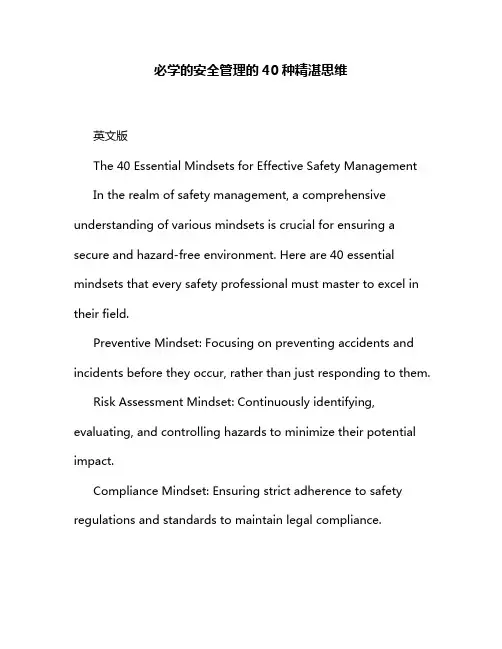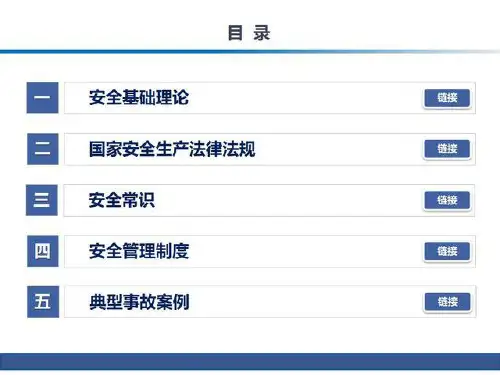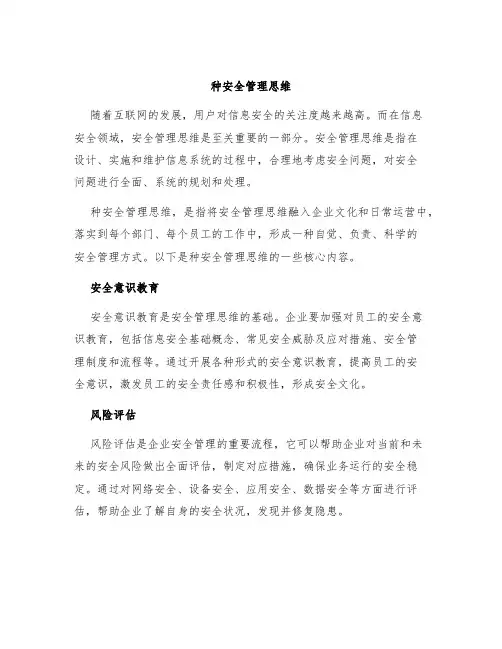40种安全管理思维(PPT44页)
- 格式:pptx
- 大小:1.18 MB
- 文档页数:45





安全管理培训ppt课件完整版•安全管理概述•安全管理体系建设•安全风险识别与评估•安全事故预防与处理目录•安全管理培训与教育•安全管理实践与应用定义:安全管理是指通过一系列组织、技术、教育等手段,对企业或组织的生产经营活动中存在的危险、有害因素进行识别、评估和控制,以保障人员安全与健康、财产安全与环境保护的过程。
重要性保障员工安全与健康,提高工作满意度和效率。
降低事故发生率,减少财产损失和法律责任。
提升企业形象和竞争力,促进可持续发展。
010*******安全管理的定义与重要性主要关注事故后的处理和惩罚,缺乏系统性和预防性。
传统安全管理阶段现代安全管理阶段未来安全管理趋势引入风险管理、安全评价等理念和方法,强调事前预防和持续改进。
借助大数据、人工智能等技术手段,实现智能化、精准化的安全管理。
030201强调事前的危险识别和预防措施,降低事故发生的可能性。
要求企业全体员工都参与到安全管理工作中,形成共同的安全文化。
通过不断检查、评估和调整安全管理措施,实现安全绩效的持续提升。
将安全管理视为一个系统工程,从组织、技术、教育等多方面进行综合施策。
预防为主原则全员参与原则持续改进原则系统化原则安全文化安全制度安全组织安全技术安全管理体系的构成01020304培养员工安全意识,形成共同的安全价值观和行为准则。
建立完善的安全管理制度,明确各级职责和权限,确保安全管理有章可循。
设立专门的安全管理机构,配备专业安全管理人员,提供组织保障。
采用先进的安全技术和装备,提高安全防范能力和水平。
结合企业实际,制定切实可行的安全管理制度,明确各项安全规定和操作流程。
制度制定通过培训、宣传等方式,使员工充分了解并遵守安全管理制度。
制度宣贯各级管理人员要带头执行安全管理制度,加强监督和检查,确保制度得到有效执行。
制度执行安全管理制度的制定与执行安全管理体系的评价与改进安全评价定期对安全管理体系进行评价,识别存在的问题和不足,提出改进措施。


必学的安全管理的40种精湛思维英文版The 40 Essential Mindsets for Effective Safety Management In the realm of safety management, a comprehensive understanding of various mindsets is crucial for ensuring a secure and hazard-free environment. Here are 40 essential mindsets that every safety professional must master to excel in their field.Preventive Mindset: Focusing on preventing accidents and incidents before they occur, rather than just responding to them.Risk Assessment Mindset: Continuously identifying, evaluating, and controlling hazards to minimize their potential impact.Compliance Mindset: Ensuring strict adherence to safety regulations and standards to maintain legal compliance.Continuous Improvement Mindset: Seeking opportunities for enhancement and refinement in safety processes and procedures.Employee Engagement Mindset: Encouraging active participation and ownership of safety measures among employees.Incident Investigation Mindset: Thoroughly examining accidents and near-misses to understand their root causes and prevent recurrences.Communication Mindset: Effective communication of safety information, instructions, and concerns across all levels of the organization.Training Mindset: Providing regular and comprehensive safety training to equip employees with the necessary skills and knowledge.Safety Culture Mindset: Promoting a strong safety culture where safety is a core value and everyone feels responsible for it.Proactive Mindset: Taking initiatives to identify and address safety issues before they become problems.Adaptive Mindset: Being flexible and responsive to changing safety challenges and environments.Collaborative Mindset: Working closely with other departments to integrate safety considerations into their operations.Auditing Mindset: Conducting regular audits to assess the effectiveness of safety measures and identify areas for improvement.Innovative Mindset: Exploring new technologies and approaches to enhance safety performance and efficiency.Emergency Preparedness Mindset: Preparing for and planning responses to emergencies to minimize their impact.Incident Reporting Mindset: Encouraging a non-punitive culture where employees feel safe reporting safety concerns and incidents.Leadership Mindset: Leading by example, demonstrating commitment to safety, and inspiring others to do the same.Safety Awareness Mindset: Staying updated on the latest safety practices and trends to stay ahead of evolving risks.Problem-Solving Mindset: Employing a structured approach to identify and address safety-related problems.Critical Thinking Mindset: Questioning assumptions, challenging常规, and seeking the best possible solutions to safety challenges.Safety First Mindset: Placing safety above all other considerations in decision-making and operations.Data-Driven Mindset: Using data and analytics to inform safety decisions and prioritize efforts.Human Factors Mindset: Recognizing the role of human behavior and limitations in accident prevention.Systems Thinking Mindset: Understanding the interconnectedness of various systems and components to ensure overall safety.Behavioral Safety Mindset: Focusing on changing unsafe behaviors and promoting positive safety habits.Learning Mindset: Always learning from experiences, both successful and failures, to improve safety practices.Protection Mindset: Ensuring employees have the necessary equipment and resources to perform their jobs safely.Sustainability Mindset: Integrating safety considerations into long-term strategic planning and sustainability goals.Accountability Mindset: Holding individuals and teams accountable for their safety performance and outcomes.Transparency Mindset: Being transparent about safety performance, challenges, and progress to build trust and engagement.Inclusivity Mindset: Valuing the input and contributions of all stakeholders in safety management.Resilience Mindset: Bouncing back from failures and challenges to learn, adapt, and improve.Integrity Mindset: Maintaining ethical standards and honesty in all safety-related decisions and actions.Customer Focus Mindset: Understanding and meeting the safety needs and expectations of customers and stakeholders.Process Improvement Mindset: Continuously refining and improving safety processes to enhance efficiency and effectiveness.Change Management Mindset: Managing change proactively to minimize its impact on safety and ensure smooth transitions.Global Perspective Mindset: Considering safety implications and practices across different cultures, regions, and industries.Continuous Learning Mindset: Staying updated with new safety knowledge, skills, and technologies to stay competitive.Safety Leadership Mindset:英文版必学的安全管理的40种精湛思维在安全管理领域,对各种思维方式的全面理解对于确保安全和无风险的环境至关重要。




种安全管理思维随着互联网的发展,用户对信息安全的关注度越来越高。
而在信息安全领域,安全管理思维是至关重要的一部分。
安全管理思维是指在设计、实施和维护信息系统的过程中,合理地考虑安全问题,对安全问题进行全面、系统的规划和处理。
种安全管理思维,是指将安全管理思维融入企业文化和日常运营中,落实到每个部门、每个员工的工作中,形成一种自觉、负责、科学的安全管理方式。
以下是种安全管理思维的一些核心内容。
安全意识教育安全意识教育是安全管理思维的基础。
企业要加强对员工的安全意识教育,包括信息安全基础概念、常见安全威胁及应对措施、安全管理制度和流程等。
通过开展各种形式的安全意识教育,提高员工的安全意识,激发员工的安全责任感和积极性,形成安全文化。
风险评估风险评估是企业安全管理的重要流程,它可以帮助企业对当前和未来的安全风险做出全面评估,制定对应措施,确保业务运行的安全稳定。
通过对网络安全、设备安全、应用安全、数据安全等方面进行评估,帮助企业了解自身的安全状况,发现并修复隐患。
安全管理流程企业需要建立完善的安全管理流程。
了解业务流程,制定安全管理计划,配合安全方案,明确各部门责任和工作流程,确保安全管理有效实施。
同时,需要不断完善和更新安全管理流程,以适应不同环境和需求。
常态化监控企业需要建立常态化监控机制,对业务系统的网络安全、设备安全、应用安全、数据安全等方面进行全面监控。
通过对日志、告警、检测等技术手段的运用,及时发现和处理安全事件,防范内外部威胁,提高安全保障能力。
事件应急响应事件应急响应是企业保障信息安全的最后一道防线。
企业需要建立完善的事件应急响应机制,明确事件分类、等级、上报、处理流程等,制定应急演练方案,提高事件应急响应能力,以便在安全事件发生时能快速、准确、高效地响应。
安全管理文档化安全管理文档化是安全管理思维的重要体现。
建立信息安全政策、规范、流程、制度等一系列安全文档,记录和管理企业安全管理的方方面面,对内逐级审批,确保安全管理措施的严密性和权威性。